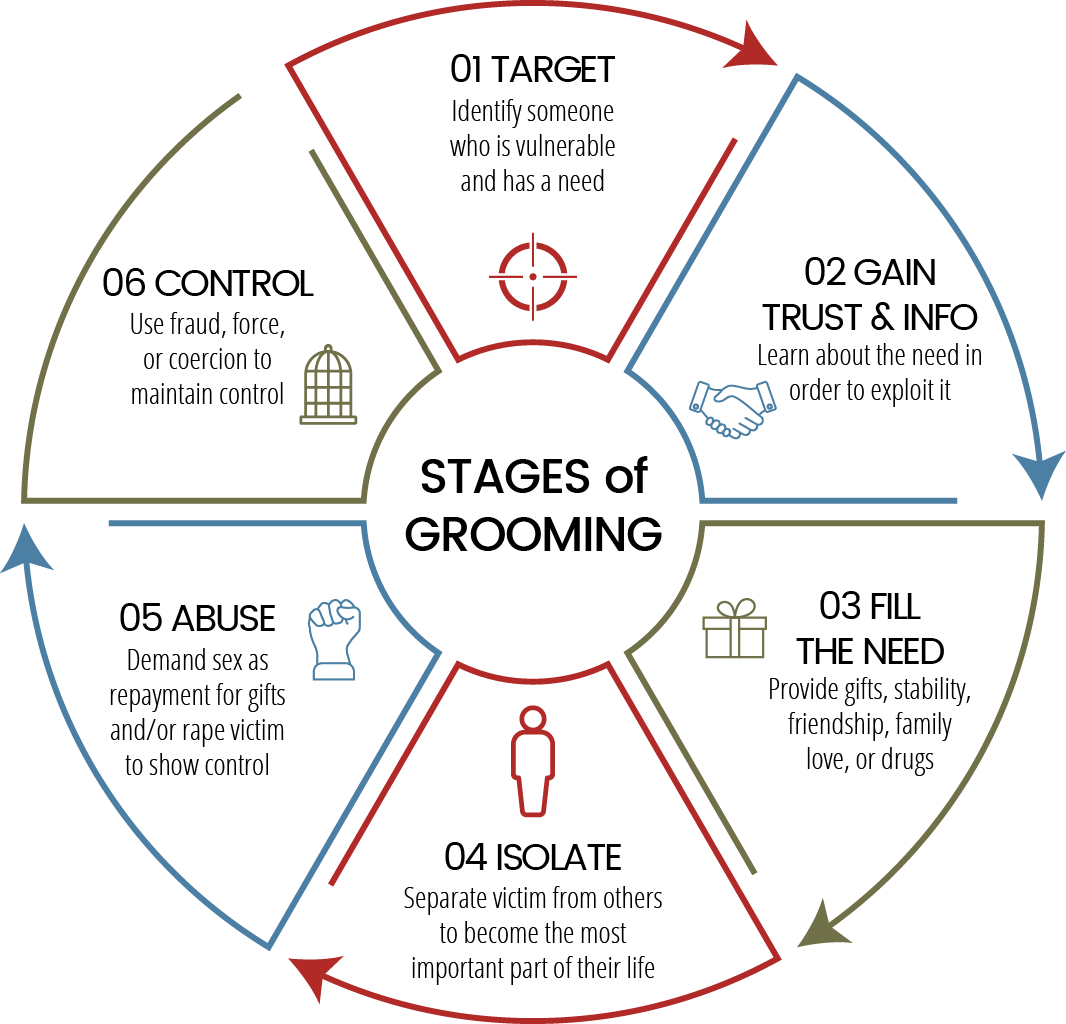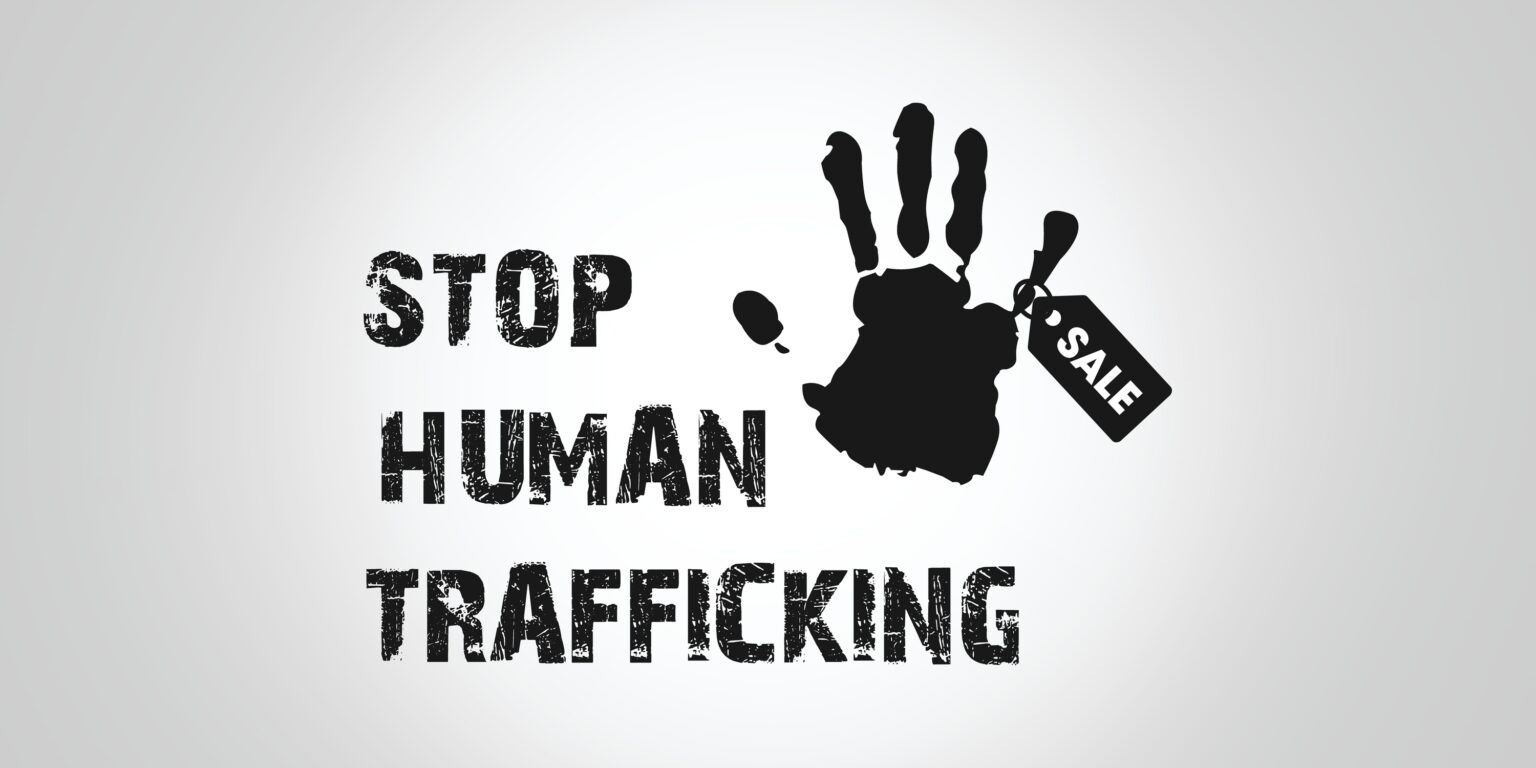Sex trafficking is a multibillion-dollar industry that affects approximately 5 million victims. It is a type of human trafficking, and modern-day slavery, that is defined by the Trafficking Victims Protection Act of 2000 as “the recruitment, harboring, transportation, provision, obtaining, patronizing, or soliciting of a person for the purpose of a commercial sex act.” Although anyone can be at risk for sex trafficking, victims are usually children and vulnerable adults.
Grooming is when a trafficker gains a person’s trust to exploit them. While movies and TV give off the impression that trafficking occurs by being violently kidnapped by a stranger, the grooming process happens in a much more subtle manner than we may think. There are 6 stages of grooming.
- The first stage is targeting. Traffickers usually prey on girls and women although boys and men can be victims too. They usually look for people who show a vulnerability they can exploit. They can meet or find their victim in person or online. Traffickers can meet children on online games, social media, and even homework sites.
- The second stage is gaining trust. This can be done by casual conversation and befriending. This provides the trafficker access to the victim.
- The third stage is filling a need or helping the victim. They use their vulnerability against them by providing whatever need they are seeking to fill. Examples include gift-giving or offering special or extra attention.
- The fourth stage is isolation of the victim. Once the predator and victim begin to spend more time with each other, the trafficker will begin to withdraw the victim from other people in their lives such as family and friends. This leaves the trafficker as the only true “friend” in a victim’s life.
- The fifth stage is sexualization and abuse. The trafficker will introduce drugs, alcohol, and pornography. The trafficker may also request sexual pictures and videos. This allows the trafficker to gain further control of the victim.
- The sixth stage is maintaining control and power. The traffickers use verbal and psychological threats, blackmail, as well as physical violence to manipulate the victim into doing what they want.

Less than 1% of sex trafficking victims are rescued. Identifying the signs of grooming can help identify a victim and even possibly save a life.
Signs to help recognize grooming and/or trafficking include:
- Regular absences from school, work, and other activities
- Being dishonest or secretive about what they are doing and with whom
- Attitude or behavior changes
- The person having a controlling parent, guardian, partner, or sponsor who limits or monitors their interactions with others
- New friends
- Being fearful, timid, or submissive
- Fearfulness of law enforcement
- Expensive gifts or a large amount of money
If you feel like someone is being trafficked or is at risk, notify law enforcement as soon as possible. A great resource is the National Human Trafficking Hotline, which is a 24-hour, multilingual, anti-trafficking hotline. The National Human Trafficking Hotline is 1-888-373-7888. Most importantly if you see something do not be nervous or afraid to talk to someone. If you see something, say something.
Download our Free Guide:
“4 Signs Someone is Being Groomed for Trafficking”
If you are interested in learning more about how to identify the red flags of grooming and trafficking, check out our online course, Red Flags.
References:
-
- 6 stages of grooming in human Trafficking: Fight to End Exploitation. 6 Signs of Grooming in Human Trafficking | Fight To End Exploitation. (n.d.). https://fighttoendexploitation.org/2019/03/01/grooming-in-human-trafficking/.
- CACs, I. (2021, February 23). 6 signs your child is being groomed for sexual exploitation. The Indiana Chapter of the National Children’s Alliance. https://incacs.org/6-signs-your-child-is-being-groomed-for-sexual-exploitation/.
- Chapko, R. (2020, September 3). Unraveling the stages of grooming. NCPTF.org. https://www.ncptf.org/post/unraveling-the-stages-of-grooming.
- Child sexual exploitation and grooming. Department of Education and Training Victoria. (n.d.). https://www.education.vic.gov.au/school/teachers/health/childprotection/Pages/expolitationgrooming.aspx.
- Indicators of human trafficking. Department of Homeland Security. (2021, June 28). https://www.dhs.gov/blue-campaign/indicators-human-trafficking.
- Recognizing the signs. National Human Trafficking Hotline. (2020, August 31). https://humantraffickinghotline.org/human-trafficking/recognizing-signs.
- Sex trafficking. National Human Trafficking Hotline. (n.d.). https://humantraffickinghotline.org/type-trafficking/sex-trafficking.
- Sex trafficking|sexual violence|violence prevention|injury center|cdc. Centers for Disease Control and Prevention. (2021, January 28) https://www.cdc.gov/violenceprevention/sexualviolence/trafficking.html.
- U.S. Department of State. (2021, January 10). Identify and assist a trafficking victim – united states department of state. U.S. Department of State. https://www.state.gov/identify-and-assist-a-trafficking-victim/.




